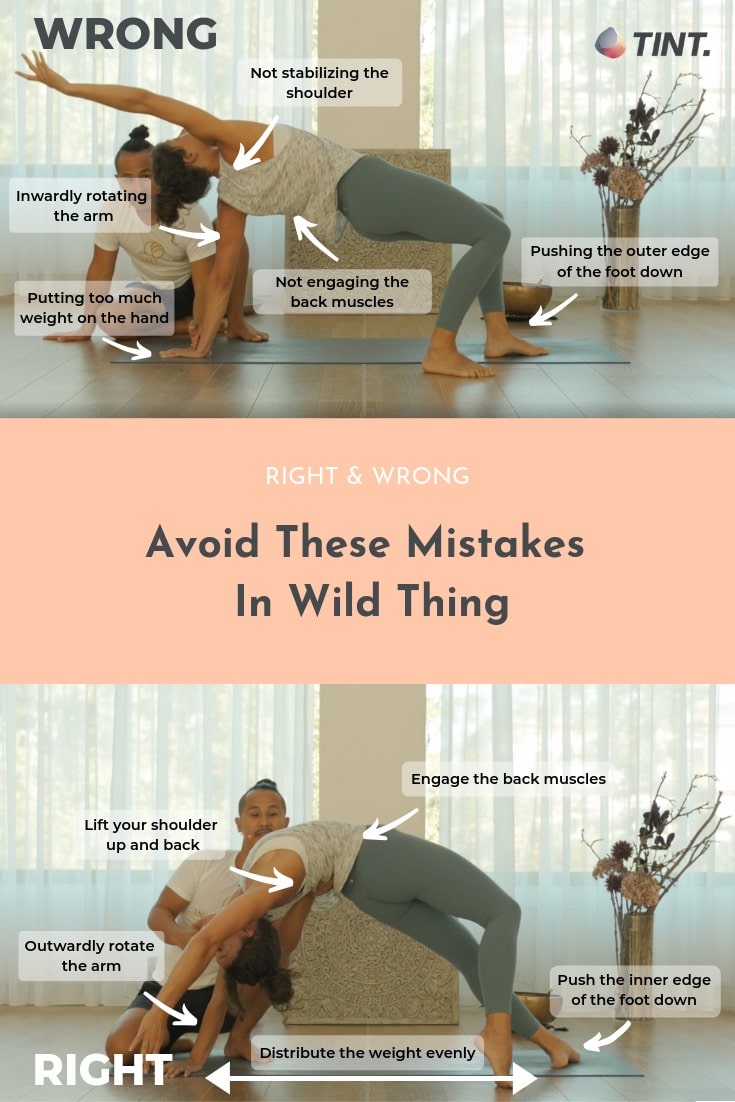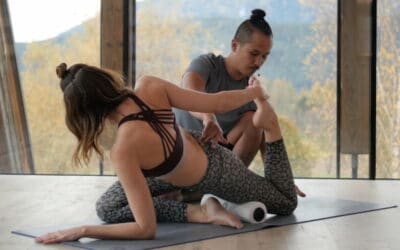Wild Thing is an asana that has many names: Rock Star, Flip Dog, or its Sanskrit name Camatkarasana. The word Camatkarasana can be translated as “the ecstatic unfolding of the enraptured heart.” This is a pretty good description of the strong back-bending yoga pose, since the open chest does not only open your heart, it also gives you strength and confidence.
In this article, you will learn how to open your heart in Wild Thing asana:
1. How Do You Get Into Wild Thing Asana?

Open your Heart Chakra in Wild Thing yoga pose with Faith Hunter’s Chakra Awakening Body & Soul on TINT.
- Start in a seated position with one leg straight and the other one bent with the foot on the floor. Place the hand of the straight-leg side on the ground behind you.
- Outwardly rotate the hand on the ground, which will also outwardly rotate your arm.
- Bend the elbow slightly and lift your shoulder up towards your ear and then bring it back.
- Outwardly rotate your upper arm even more and straighten your arm.
- Lift your buttocks up to come into the pose.
- Push the inner edge of your straight leg into the ground so that you can lift your hip further up.
- Push the mat away with the hand that is on the floor. This will help you to lift up your shoulder.
- Lift your heart up and keep your legs strong.
- Bring the hand of the bent-leg side behind your head and bring the elbow closer to you so that it faces upwards. Push the back of your head against the hand. This will support you in engaging your back muscles.
- Straighten the arm again and bring both shoulders towards your ear.
- Outwardly rotate this arm as well and, if available to you, you can touch the ground.
Enough theory for now. It’s time to practice. Let Young Ho Kim guide you step by step through Wild Thing asana in his Inside Yoga Alignment program on TINT. There even is a video explaining you the most common alignment mistakes in a special right & wrong video.
Learn proper Wild Thing alignment with Young Ho Kim’s Inside Yoga Alignment on TINT.
2. What Is Your Body Doing In Wild Thing Asana?
2.1. What Are the Joints Doing?
As in all back-bending asanas, your spine is extended in Camatkarasana. In the upper limbs, the scapulae are upwardly rotated and elevated and the shoulders are flexed. Both elbows are extended while the forearms are pronated. The wrist of the weight-bearing arm is in dorsiflexion while there’s palmar flexion in the wrist that is in the air. The hand and fingers are extended.
In the lower limbs, the hip is extended and adducted. The knee of the weight-bearing leg is extended or slightly flexed, depending on your mobility. The knee on the other leg is flexed. Both ankles are in plantar flexion.
2.2. Which Muscles Are Engaged?
The main actors in your spine are the spinal extensors to maximize the extension of the spine. The psoas minor and the abdominal muscles are contracting eccentrically in order to prevent the lumbar spine from hyperextending.
Let’s have a look at the muscles engaged in the shoulder girdle, arms and hands:
- The serratus anterior contracts concentrically to upwardly rotate and elevate the scapulae.
- The deltoid and the rotator cuff muscles stabilize and protect the shoulder joints.
- The biceps brachii and the anterior deltoids contract concentrically to flex the shoulders.
- The triceps brachii contract eccentrically to extend the elbows.
- The pronator quadratus and teres pronate the forearm.
- The intrinsic muscles of the wrists and hands help to maintain the integrity of the hands.
In the lower limbs, the following muscular actions are relevant:
- The hamstrings and the gluteus maximus contract concentrically to extend the hip.
- The adductor magnus and the gracilis extend and adduct the hip.
- The articularis genu and vastii contract eccentrially to extend the knee.
If you want to learn more about proper alignment in other yoga poses as well, check out our free yoga asana ebook. It will give you a basic understanding of the alignment in some of the most common asanas. You definitely don’t want to miss it!
3. Do You Make These Mistakes In Wild Thing?
1. Too Much Weight On Your Hand
One of the most common mistakes in Wild Thing is that you put too much weight on your hand and there is almost no weight on your leg. Instead, distribute the weight more evenly.
2. Inwardly Rotating Your Arm
If you inwardly rotate the hand that is on the floor, your arm will also rotate inwardly. Keeping it straight in addition to that, will significantly decrease the range of motion you have in your shoulder.
So, to open your shoulders, outwardly rotate your weight-bearing hand so that your arm rotates along with it. This means that your fingers will not point forward, but rather to the side underneath your body.
3. Not Stabilizing the Shoulder
Before you come into Wild Thing asana, it’s important to bring your shoulder into proper alignment. So, before coming into the pose, lift your shoulders up and back. Bring the tips of the shoulder blades towards each other and then lift your chest forward and up.
This is very important to stabilize your shoulders and open up your chest.
4. Pushing The Outer Edge of the Foot Down
Another quite common mistake is that students push the outer edge of the foot, i.e. the side that is facing towards your buttocks in Wild Thing, into the mat. As a result, the hip collapses.
If, on the other hand, you push the inner edge of the foot (facing away from you) into the mat, you have strong and engaged legs so that you can elevate your hip.
5. Not Engaging the Back Muscles
One thing that is often neglected in Wild Thing is the engagement of your back muscles although they are very important to keep your spine aligned.
In order to activate the muscles in your back, bring the lifted hand against the back of your head. Push your head agains your hand and your hand against your head. You will feel the engagement of your back.

Learn how to do Wild Thing correctly with Young Ho Kim’s Inside Yoga Alignment.
4. How Can You Build Wild Thing Into Your Yoga Practice?
Wild Thing is a very powerful yoga pose and, as such, is often practiced in dynamic yoga formats like Vinyasa yoga, Power yoga or Inside Flow yoga, such as the Inside Flow program to the song Pillow Talk that you can practice with Young Ho Kim on TINT:
Experience Wild Thing in a dynamic Inside Flow class on TINT.
Since it’s a very demanding asana, it may be a good idea to prepare your body for this yoga pose by first strengthening the back muscles (such as the erector spinae, back extensors, posterior deltoids and the triceps) and stretching the front side of the body (the rectus abdomonis, the pectorals, anterior deltoids and the biceps) with postures where you have a lower centre of gravity. This can include poses like Sphinx (Salamba Bhujangasana), Cobra (Bhujangasana), Locust (Salabhasana), or Bow (Dhanurasana).
Side Plank and its variations can also help to further prepare your shoulder girdle and side body for Wild Thing.
Another great way to further stretch and strengthen the spine and the entire front of the body is practicing Sun Salutations. This well-rounded set of yoga poses also stretches and tones the shoulder and the muscles of the hip girdle such as the psoas, the gluteus maximus and medius, as well as the deep external rotators, hamstrings and quadriceps.
You could also raise and bend one leg and open your hip in Downward-Facing Dog (Adho Mukha Svanasana) for a Scorpion Tail variation. This will release tightness and tension from your obliques, psoas and quadriceps. The same can be achieved by practicing standing hip openers such as Warrior 2 or Triangle.

Prepare for Wild Thing asana with a Scorpion Tail variation of Downward Dog.
You can also transition into Wild Thing from Downward-Facing Dog (Adho Mukha Svanasana):
- Shift your weight into one side of your body. Let the fingers of that hand point towards the outside of the mat and roll onto the outer edge of that foot as if you were moving into Side Plank.
- Draw your shoulders up and back and push the hand into the ground to lift your hips up.
- Step the other foot back and place your toes on the floor with your knee partially bent.
- Curl back through your upper back to create a sweeping action of the shoulder blades into the back of the rib cage.
- Lift your hips higher until you curl more into a backbend and now press the inner edge of the straight leg solidly into the ground.
Another way to smoothly transition into Wild Thing asana from Three-Legged Downward Dog is by reaching the lifted leg through the opposite armpit. Press the foot into the ground and sweep the arm up to open your heart. Watch this video to practice this sequence with Sianna Sherman in her Rasa Yoga Warrior Practice:
Transition smoothly into Wild Thing asana with Sianna Sherman‘s Rasa Yoga Warrior Practice on TINT.
Especially in powerful and demanding asanas such as Wild Thing, understanding the correct alignment of a yoga pose is essential to avoid pain or injury. That’s why we have summarized the most important alignment fundamentals of 10 of the most common asanas in a free ebook that you can download for free and use as a reference guide for your practice.
5. What Are the Benefits of Wild Thing Asana?
Just like other backbends such as Cobra pose or Camel pose, Wild Thing is a yoga pose that stretches the entire front body. This means that it opens up the chest and shoulder area and, thus, creates space in the heart and lungs, boosting the lungs’ performance.
While expanding the chest, it also strengthens the shoulders and the upper back and improves the spine’s flexibility. At the same time, it’s great yoga pose to strengthen your arms and wrists.

Wild Thing: an asana of strenght & grace.Photo: TINT Instructor Barbra Noh by by Christian Krinninger.
Moving further down the body, Camatkarasana opens the front of the legs and the hip flexors. It also is a strong pose said to energize the body and promote blood circulation.
If you are eager to experience the great benefits of backbends like Wild Thing yoga asana yourself, we’ve got you covered.There are several programs on TINT where you can feel the great effects that backbends can have on your flexibility, posture and overall well-being. You can, for example, practice backbends with Finlay Wilson or learn how to Master Your Backends with Mathieu Boldron. Make sure you also check out Barbra Noh‘s Bamboo Backbends. Since this yoga pose is also said to open your heart chakra (the 4th chakra), you should definitely not miss Faith Hunter‘s Chakra Awakening Body & Soul. Go wild!
Open your heart chakra in Wild Thing with Faith Hunter‘s Chakra Awakening Body & Soul on TINT.





